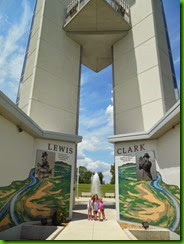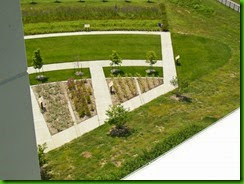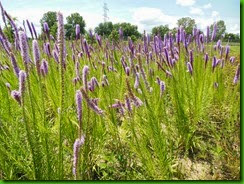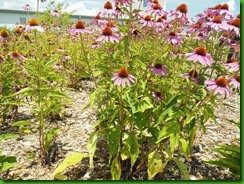The Lewis and Clark Confluence Tower, in Hartford, Illinois, where the Missouri and
Mississippi Rivers meet, honors the men’s contribution to the opening of the
West to settlement and gives the tourist a view of the joining of the rivers a
mile or so distant over flood plains. Surrounding
the stark concrete structure are gardens containing plants Lewis and Clark saw
on their journey. One of the men’s tasks
was to catalog and to send back to Jefferson specimens of plants and animals
they found on the trip, many of which were unknown to science at the time. Of course, these plants were known to Native Americans, but they were novelties to the European settlers.
 |
| At the Lewis and Clark Confluence Tower |
 |
| In the trees is the confluence of the Missouri and Mississippi Rivers. In foreground is the Mississippi River. |
 |
| Lewis and Clark Confluence Tower |
Native plants are those that are found in the wild within a
particular climate. Many plants in our
gardens originate in China or England, and are happiest in those climates. Gardens of primroses, tulips, delphiniums,
and lilacs won’t grow in South Carolina; they need cool summers.
 |
| View of the native plant gardens from the tower |
Some plants like our heat, cool winters, and humidity. I saw many of those same plants in the
Missouri native plant gardens, although the plants were larger there than
here. Maybe it’s because of the
beautiful Midwestern topsoil in which they grow, or maybe it’s because of the
extra hours of daylight the plants receive further west. I wonder if the plants know winter will come
to freeze them soon, and so they put forth extra effort to grow large in their
allotted time.
 |
| Liatris growing much taller than it does in my garden. |
The healthiest plants in my garden are plants native to the
Southern US, and many of these plants are native to Missouri. Insects such as bees and butterflies prefer
these species. Fall is the perfect time
to plant perennials; the plants will have the cool fall, winter, and spring to
become established before they must suffer through another hot summer.
 |
| Achillea, or yarrow, that's gone to seed, in the foreground |
If you’d like to include native plants in your garden,
consider planting spring and early summer blooming plants like Achillea or
yarrow, Baptista, phlox, and bee balm, and plants that bloom later in the
summer and into the fall like Rudbekia or coneflower, butterfly weed (a host
plant for monarch butterflies), coreopsis, Joe Pye weed, and liatris. Among these plants, numerous colors are
available.
Coneflower
To maintain a garden of perennials, cut them to the ground
after the first frost. I prefer to do
this with a weed-eater, and I leave the clippings where they fall as
mulch. Then over the clippings, I
sprinkle a layer of mulch to provide coverage a few inches deep, avoiding the
crowns of the plants. My garden-keeping
chores are over for another year, besides pulling the stray weed that meanders
through the mulch, or clipping spent blooms to encourage the plants to repeat
their blossoms.

